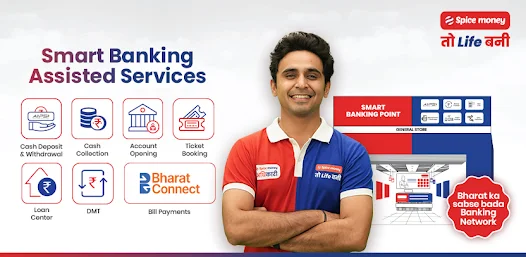Kiosk banking is transforming financial services by bringing essential banking functions closer to underserved populations. With the rise of kiosk banking mini branches, individuals in remote and rural areas now have better access to banking services without the need to visit traditional bank branches. These mini branches serve as an extension of banks, allowing customers to perform essential transactions conveniently.

Kiosk banking mini branches leverage technology to provide secure and cost-effective banking solutions. These outlets operate through business correspondents, who act as intermediaries between banks and customers. The growing adoption of kiosk banking is driving financial inclusion by offering account opening, deposits, withdrawals, and money transfers. As more institutions embrace this model, kiosk banking is poised to redefine the way banking services are delivered.
What is Kiosk Banking?
Kiosk banking refers to a system that enables banking services through small-scale, technology-driven outlets. These kiosks are operated by authorized agents, allowing customers to access financial services with ease. The introduction of kiosk banking mini branches has helped bridge the gap between conventional banking and unbanked populations.
Unlike full-fledged bank branches, kiosk banking mini branches require minimal infrastructure and operational costs. This model ensures that banking facilities reach even the most remote locations, making financial services more inclusive. With biometric authentication and digital transactions, kiosk banking enhances security while reducing the dependency on physical cash.
How Kiosk Banking Mini Branches Work
Kiosk banking mini branches function as intermediaries between banks and customers, offering essential services through authorized agents. These mini branches operate through digital platforms, making transactions seamless and efficient.
Key Features of Kiosk Banking Mini Branches:
- Account Opening: Customers can open savings or current accounts with minimal documentation requirements.
- Cash Deposits & Withdrawals: Users can deposit and withdraw money conveniently without visiting traditional banks.
- Fund Transfers: Transactions between accounts are made easy, even for those without access to smartphones or internet banking.
- Bill Payments & Recharge Services: Customers can pay utility bills and recharge mobile services through these kiosks.
- Microfinance & Loan Services: Some kiosk banking mini branches also facilitate microloans and financial assistance programs.
Benefits of Kiosk Banking Mini Branches
Kiosk banking mini branches have revolutionized financial accessibility, offering a range of benefits for both customers and financial institutions.
1. Enhanced Financial Inclusion
Kiosk banking has bridged the gap for individuals who previously lacked access to formal banking services. By providing banking solutions in remote areas, kiosk banking mini branches empower communities with financial independence.
2. Cost-Effective Banking Model
Traditional bank branches require significant investment in infrastructure and operational expenses. Kiosk banking mini branches, on the other hand, offer an affordable alternative, reducing costs for banks while ensuring services reach the last mile.
3. Convenience and Accessibility
Customers no longer need to travel long distances to visit banks. With kiosk banking mini branches located in local communities, financial transactions become faster and more convenient.
4. Secure and Transparent Transactions
Kiosk banking utilizes biometric authentication and digital verification methods, ensuring secure and fraud-free transactions. Additionally, the digital record-keeping system enhances transparency in banking operations.
5. Empowering Small Businesses
Kiosk banking mini branches provide business owners with an opportunity to offer banking services while earning additional income. These kiosks create employment opportunities and boost local economies.
Challenges in Kiosk Banking
Despite its advantages, kiosk banking also faces certain challenges that need to be addressed for sustainable growth.
1. Limited Awareness and Digital Literacy
Many potential users are unaware of kiosk banking services or lack the digital skills to utilize them effectively. Raising awareness and providing financial education is crucial for adoption.
2. Connectivity and Infrastructure Issues
In remote areas, unreliable internet connectivity can hinder the smooth functioning of kiosk banking mini branches. Investments in digital infrastructure are necessary to enhance service efficiency.
3. Regulatory Compliance
Ensuring that kiosk banking mini branches comply with financial regulations and security measures is essential. Banks and service providers must work together to maintain compliance with banking norms.
4. Operational Scalability
Expanding kiosk banking mini branches requires financial institutions to manage resources effectively. Efficient agent management and service standardization play a crucial role in sustainable growth.
The Future of Kiosk Banking Mini Branches
Kiosk banking is set to play a significant role in the future of financial services. With advancements in technology and increasing digital adoption, kiosk banking mini branches will continue to evolve.
1. Integration of Digital Banking Solutions
Future kiosk banking models will integrate digital payment solutions, making transactions even more seamless. The adoption of AI-driven financial services will enhance customer experience and service efficiency.
2. Expansion of Services
Beyond basic banking transactions, kiosk banking mini branches will offer more financial products, including insurance, investment opportunities, and microcredit services.
3. Increased Collaboration with Financial Institutions
Banks will continue to collaborate with kiosk banking service providers to expand their reach. This partnership will enable the banking sector to penetrate untapped markets efficiently.
4. Enhanced Security Measures
With evolving cybersecurity threats, kiosk banking mini branches will implement advanced security protocols such as blockchain technology and multi-factor authentication to protect customer data.
Conclusion
Kiosk banking is revolutionizing financial services by providing essential banking functions to underserved communities. The emergence of kiosk banking mini branch has transformed the accessibility of banking services, allowing individuals to manage their finances conveniently. As kiosk banking continues to expand, it will play a pivotal role in driving financial inclusion and economic growth.
The future of kiosk banking mini branches lies in technological innovation, enhanced security, and broader financial services. As more individuals adopt this model, kiosk banking will reshape the traditional banking landscape, ensuring that financial services are accessible to all. By addressing challenges and embracing digital advancements, kiosk banking will remain a cornerstone of modern financial inclusion strategies.